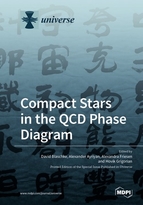Compact Stars in the QCD Phase Diagram
A special issue of Universe (ISSN 2218-1997).
Deadline for manuscript submissions: closed (6 January 2018) | Viewed by 66806
Special Issue Editors
2. Center for Advanced Systems Understanding (CASUS), D-02826 Görlitz, Germany
3. Helmholtz-Zentrum Dresden-Rossendorf (HZDR), D-1328 Dresden, Germany
Interests: quantum field theory; quantum statistics; quark gluon plasma; heavy ion collisions; compact stars
Special Issues, Collections and Topics in MDPI journals
Special Issues, Collections and Topics in MDPI journals
Special Issues, Collections and Topics in MDPI journals
2. Yerevan State University, Alek Manyukyan 1, 0025 Yerevan, Republic of Armenia
Special Issue Information
Dear Colleagues,
This special issue is dedicated to the conference: Compact Stars in the QCD Phase Diagram VI http://theor.jinr.ru/~hmec/csqcd6/.
This special issue will cover the following main topics:
- QCD phase diagram for HIC vs. astrophysics
- Quark deconfinement in HIC vs. supernovae, neutron stars and their mergers
- Strangeness in HIC and in compact stars
- Equation of state and QCD phase transitions
Prof. Dr. David Blaschke
Dr. Hovik Grigorian
Mr. Alexander Ayriyan
Dr. Alexandra Friesen
Guest Editors
Manuscript Submission Information
Manuscripts should be submitted online at www.mdpi.com by registering and logging in to this website. Once you are registered, click here to go to the submission form. Manuscripts can be submitted until the deadline. All submissions that pass pre-check are peer-reviewed. Accepted papers will be published continuously in the journal (as soon as accepted) and will be listed together on the special issue website. Research articles, review articles as well as short communications are invited. For planned papers, a title and short abstract (about 100 words) can be sent to the Editorial Office for announcement on this website.
Submitted manuscripts should not have been published previously, nor be under consideration for publication elsewhere (except conference proceedings papers). All manuscripts are thoroughly refereed through a single-blind peer-review process. A guide for authors and other relevant information for submission of manuscripts is available on the Instructions for Authors page. Universe is an international peer-reviewed open access monthly journal published by MDPI.
Please visit the Instructions for Authors page before submitting a manuscript. Submitted papers should be well formatted and use good English. Authors may use MDPI's English editing service prior to publication or during author revisions.







